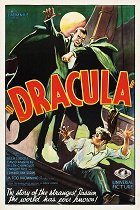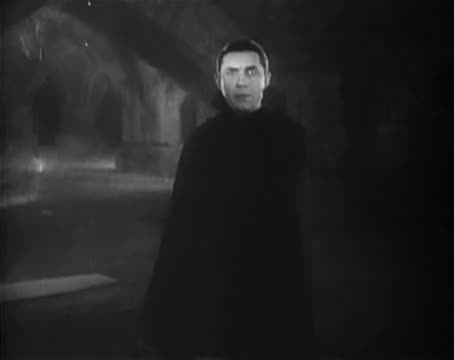Directed by:
Tod BrowningCinematography:
Karl FreundCast:
Bela Lugosi, Helen Chandler, David Manners, Dwight Frye, Edward Van Sloan, Herbert Bunston, Carla Laemmle, Tod Browning, Anita Harder, Cornelia Thaw (more)VOD (1)
Plots(1)
After a harrowing ride through the Carpathian mountains in eastern Europe, Renfield enters castle Dracula to finalize the transferral of Carfax Abbey in London to Count Dracula, who is in actuality a vampire. Renfield is drugged by the eerily hypnotic count, and turned into one of his thralls, protecting him during his sea voyage to London. After sucking the blood and turning the young Lucy Weston into a vampire, Dracula turns his attention to her friend Mina Seward, daughter of Dr. Seward who then calls in a specialist, Dr. Van Helsing, to diagnose the sudden deterioration of Mina's health. Van Helsing, realizing that Dracula is indeed a vampire, tries to prepare Mina's fiancé, John Harker, and Dr. Seward for what is to come and the measures that will have to be taken to prevent Mina from becoming one of the undead. (official distributor synopsis)
(more)Reviews (5)
The one that started the hugely successful Universal horror franchise. But it should be noted that Friedrich Murnau beat Tod Browning by knock-out, his expressionistic take from 1922 was much more suited to the lord of darkness and evil. Here, the plot rushes along like a stampede and all the potentially interesting stuff is reduced to a minimum. The scenes of Transylvania and Dracula's castle are done in 10 minutes, albeit with very nice sets (and armadillos instead of rats), the voyage to Demeter lasts 2 minutes, with only two shots alternating – on the deck of the ship, with the sea crashing over it, and a static view of Dracula – well, and the vast majority of the running time is set in the streets of London and boring interiors with enough atmosphere to fit under a mere fingernail. I also have a problem with Bela Lugosi himself. His demonic-ness here is created by the lighting of his eyes in the macro details, otherwise when he throws on his typical smirk I just expect him to utter his legendary "Beware. Beware of the big, green dragon that sits on your doorstep. He eats little boys, puppy dog tails and big, fat snails." Yes, Ed Wood just ruined the demonic aura of Bela for me :o)
()
Tod Browning's version of Dracula leaves behind two essentials characteristic of Friedrich Wilhelm Murnau's previous version: the expressionist mastery of the form and vision of Dracula as an inhuman monster. The first diversion is clearly detrimental, as the film feels visually quite unconvincing, and a certain artificiality, unlike expressionist backdrops, breaks down the genius loci of the film. More than two-thirds of the film takes place in a boring parlor setting in England, with the script sharply reducing Romania's exposure and the finale at Whitby Abbey. The middle part gets tangled up in repetitions of similar dialogues and scenes, and I can't help but think if Dracula isn't on screen, it's all a bit boring. Browning seems cumbersome as a filmmaker - the editing is very messy, and unlike James Whale (who shot Frankenstein that same year), he doesn't have the same gift for composition of the image. But the second diversion makes up for almost everything. Bela Lugosi gave Dracula the aristocratic dimension that Max Schreck denied him, and amplified the demonicness and charisma that is part of the Transylvanian count. His "I am... Dracula" is a unique testimony of how deep Lugosi immersed himself in the character and how much he enjoyed every word. The details on his face with expressionist-accented eyes do not look ridiculous at best, even in times of splatter and slime. It is his work that has made this version of Dracula a cult classic, albeit, for example, in the 1960s. Coppola's version is much more perfect in terms of filmmaking.
()
This certainly isn’t Universal’s first horror, but it was Dracula that kicked off the golden monster age of this studio. But it’s neither a breakthrough nor is it lively. That can only be said as of his younger brothers in the shape of Frankensteins, werewolves and Invisible Men. On the other hand, it’s true that I only saw Browning’s version which, despite being a talkie, still distinctly wallows in the formal approaches of the silent era of cinema. I think the simultaneously filmed Spanish version would have suited me better. But our paths have alas not yet crossed. But they will. American version: 3/5, Spanish version: ?/5
()
If Dracula had been mute, it would certainly be better - Bela Lugosi's hypnotic looks would remain, and the other acting performances would only benefit therefrom. This, you can say, is a slightly above-average film in which a lot bothers me (for example, the evident theatricality or that a lot of important things happen off camera) and only the new music by Philip Glass and the Kronos Quartet from 1999 made it into a good spectacle suitable to re-watch. I recommend it. And on top of that - were it not for this Dracula, Mel Brooks would never have made one of his best parodies.
()
I’ve never been a fan of the Dracula story, for one thing, it never presented me with as many horror and frightening moments as I would expect from such material, and most importantly, vampires as movie monsters are simply passé. The only thing that moves this original to the position of a horror classic is the demonic Bela Lugosi, who played the Transylvanian Count with great gusto and gave him a dimensionless charisma that not even the slick Gary Oldman could match. Otherwise, the technical execution is quite lacking, the atmosphere works only in places (when Lugosi is on stage), and I don’t think Browning was very proud of the flawed finale. But the film is certainly worth the waste of time-if only for Lugosi and his opening "I am.... Dracula," which the actor savours with a gusto rarely seen. 70%
()

